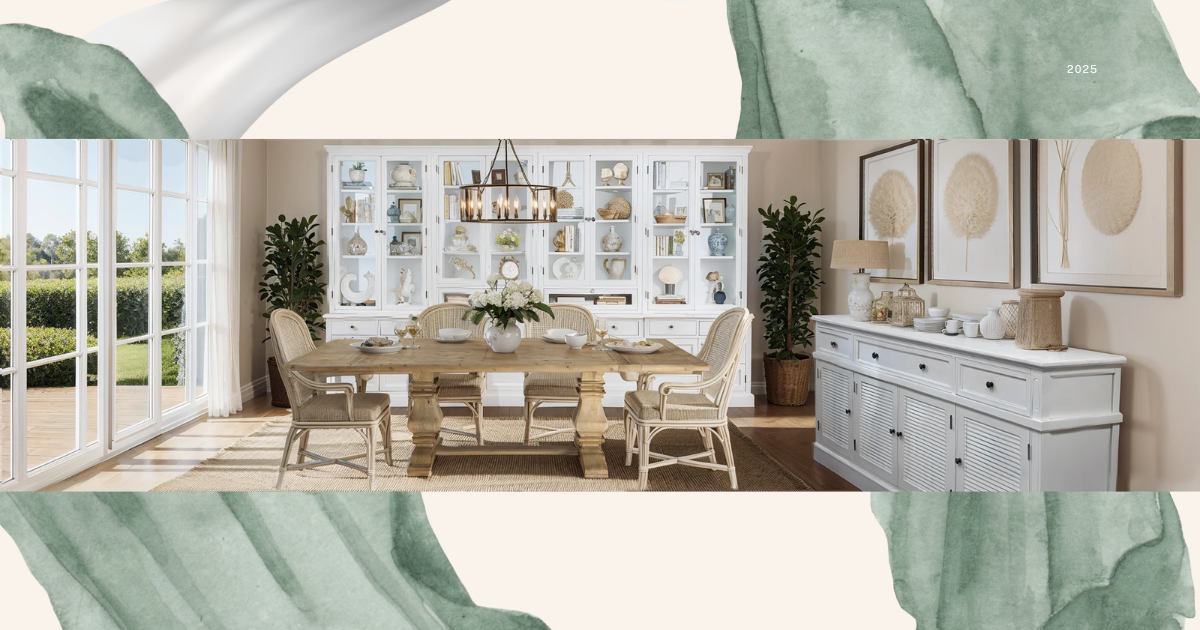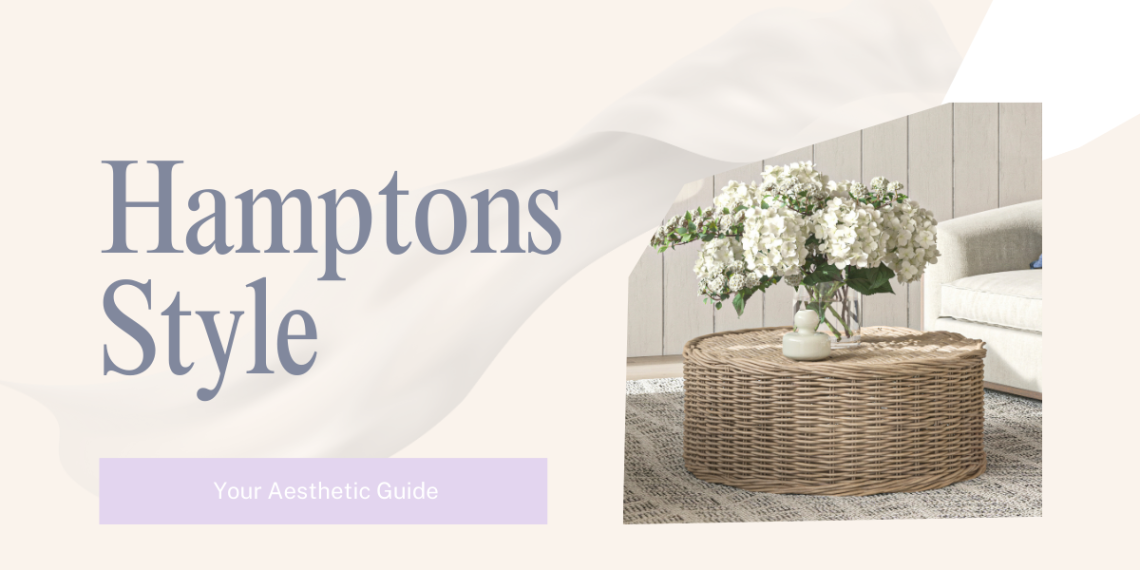Understanding Hamptons Style in Home and Furniture Design
Hamptons style, a hallmark of coastal elegance, has become a beloved interior design aesthetic worldwide, particularly in Australia and the United States, and it’s easy to see why. Bringing together the luxurious look of the Hamptons’ beachside homes (a collection of affluent towns on Long Island, New York) this enduringly beautiful style blends relaxed coastal charm with sophisticated luxury.
It evokes the serene, breezy ambience of a seaside retreat while maintaining a timeless, polished look, which has made Hamptons style furniture a hit with those who prefer more understated looks but don’t want the more sterile aesthetic of minimalist homes.
Our style of interior design is rooted in timeless elegance, blending classic elements with modern sensibilities to create spaces that feel both fresh and familiar. We prioritize natural materials, soft color palettes, and thoughtful details that lend warmth without overwhelming the room.
Each project begins with a deep understanding of how people live and move through their spaces, allowing us to craft interiors that are both beautiful and deeply functional. Incorporating reliable resources such as https://www.cynergence.com/services early in the process helps streamline execution and maintain design integrity throughout. It’s less about following trends, and more about creating an environment that feels collected, intentional, and quietly confident.
So, what is the essence of the Hamptons style in home and furniture design? Today, we’ll be delving into its origins, as well as providing practical tips for incorporating it into your own space.
Where Does “Hamptons Style” Come From?
When we look at the great styles of modern decor, we are often looking towards evoking the look and feel of particular geographic areas. Culture doesn’t come from nowhere, after all, and when we look to the origins of even the most ubiquitous of aesthetics, it’s important to look at the space they originated from for inspiration. In our case today, this particular origin takes us to Long Island, New York, a mecca of art and culture over the 20th and 21st centuries.

The Laid Back Opulence of the Hamptons
The Hamptons, including towns like Southampton and East Hampton, have long been a summer haven for wealthy New Yorkers seeking respite from city life. Since the late 19th century, grand holiday homes were built along these shores, combining colonial and Victorian influences with a focus on comfort and relaxation.
By the 1980s, the area’s celebrity allure and architectural elegance cemented its status as a symbol of coastal opulence. Hamptons style, as an interior design concept, draws from these homes, capturing their airy, light-filled interiors and effortless sophistication. A luxury interior design approach rooted in this aesthetic embraces natural textures, crisp white palettes, and refined coastal elements, creating spaces that feel both grand and inviting, timeless yet relaxed.
Over time, the style has transcended its American roots, resonating globally, especially in Australia’s coastal regions where the climate and lifestyle align perfectly.
What Makes Hamptons Style, Well, Hamptons?
Hamptons style is defined by a harmonious blend of casual comfort and refined elegance. In other words, it is the meeting point between luxury and comfort, evoking a sense of upper-class beachy design which, for understandable reasons, works very well with the modern Australian home.
Despite this somewhat vague set of principal elements discussed above, there are many aesthetic aspects that have steadily made their way into becoming “essentials” of the Hamptons-style design. These include:
Light, Neutral, and Coastal Colour Palettes
The Hamptons colour scheme is anchored in crisp whites, soft beiges, and creams, creating a neutral backdrop that feels fresh and airy. These are complemented by shades of blue and subtle greens, evoking the ocean and sky.
Accents of grey, taupe, or sandy tones add warmth, while dark-painted timbers or silver nickel provide contrast. This palette reflects the coastal landscape, fostering a serene, inviting atmosphere.
For walls, low-sheen paints like the Natural White from Dulix are recommended to maintain a modern yet classic look. After all, white walls are what tie all of these disparate looks together into one bright and complete whole. It’s also where many of the references to minimalism come into play, as both share quite sparse colour notes.
Natural Material Textures
Natural materials are central to the Hamptons style, emphasising a connection to the outdoors. Furniture often features solid woods like teak, oak, or mahogany, either whitewashed or left with a natural patina for a weathered, coastal feel.
Linen, cotton, and wool dominate upholstery and soft furnishings, offering comfort and durability. Rattan, wicker, and cane add organic texture, used sparingly in chairs or accent pieces to avoid a shabby-chic vibe. Jute or sisal rugs soften timber floors, enhancing the tactile, beach-inspired aesthetic.
The Timeless Look of Hamptons Style Furniture
Hamptons furniture prioritises comfort without sacrificing elegance. Oversized sofas and armchairs, often slipcovered in linen or cotton, invite lounging and socialising. These pieces feature clean lines, tufted fabrics, or studded detailing for a touch of refinement.
Classic silhouettes such as pedestal legs, cross detailing, or moulded edges add sophistication to dining tables, sideboards, and bedsides. Matching collections ensure cohesion, while mismatched pieces, like an antique dining table with slipcovered chairs, add character. The focus is on high-quality, durable designs that stand the test of time.
Modern Hamptons: A Contemporary Twist
While traditional Hamptons style leans on classic elements, the modern interpretation introduces sleeker, more minimal designs. Clean lines, subtle geometric patterns, and metallic or glass accents add a contemporary edge. Furniture is lighter, with delicate legs or open bases to enhance the sense of space. Patterns are toned down, favoring subtle stripes over bold florals, letting natural textures take centre stage. This evolved style maintains the serene, coastal charm but feels fresher and less ornate, usually seen in a New York vacation home renovation which are also appealing to urban dwellers or those seeking a less traditional look.
Why Hamptons Style Endures
Hamptons style’s enduring appeal lies in its ability to balance luxury with livability. It creates spaces that feel like a permanent vacation—relaxed yet refined, casual yet elegant. Its versatility suits coastal homes and urban apartments alike, making it a favourite for those seeking a serene escape. In Australia, the style’s alignment with the beachside lifestyle has led to a unique adaptation, incorporating local hues and flora, as noted by Provincial Home Living.
Whether you’re furnishing a beach house or refreshing a city dwelling, Hamptons style offers a timeless framework to craft a sophisticated, welcoming home. By blending natural materials, a coastal palette, and comfortable furniture, you can create a space that feels both luxurious and effortlessly at ease—a true reflection of the Hamptons’ seaside charm.


